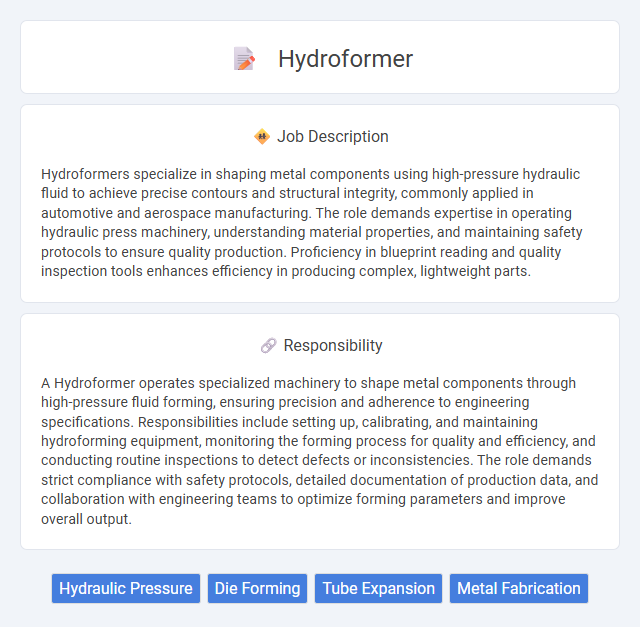
Hydroformers specialize in shaping metal components using high-pressure hydraulic fluid to achieve precise contours and structural integrity, commonly applied in automotive and aerospace manufacturing. The role demands expertise in operating hydraulic press machinery, understanding material properties, and maintaining safety protocols to ensure quality production. Proficiency in blueprint reading and quality inspection tools enhances efficiency in producing complex, lightweight parts.
Individuals with strong physical stamina and the ability to work in high-temperature environments may be more suitable for a Hydroformer job. Those who handle repetitive tasks well and can maintain focus in a fast-paced setting could likely thrive in this role. People with underlying health conditions or sensitivities to heat might find this job challenging and less appropriate for their wellbeing.
Qualification
Hydroformer job candidates must have a high school diploma or equivalent, with preferred experience in metal forming or manufacturing environments. Proficiency in operating hydroforming machinery, understanding technical drawings, and maintaining safety standards is essential. Strong mechanical aptitude, attention to detail, and the ability to work in fast-paced production settings improve job performance.
Responsibility
A Hydroformer operates specialized machinery to shape metal components through high-pressure fluid forming, ensuring precision and adherence to engineering specifications. Responsibilities include setting up, calibrating, and maintaining hydroforming equipment, monitoring the forming process for quality and efficiency, and conducting routine inspections to detect defects or inconsistencies. The role demands strict compliance with safety protocols, detailed documentation of production data, and collaboration with engineering teams to optimize forming parameters and improve overall output.
Benefit
The Hydroformer job likely offers substantial benefits such as competitive wages and comprehensive health insurance, increasing likely job satisfaction and financial stability. Opportunities for skill development and career advancement might enhance long-term employability in the manufacturing sector. Safety protocols and a structured work environment could contribute to employee well-being and reduced workplace accidents.
Challenge
The Hydroformer job likely involves navigating complex operational challenges due to the precision required in shaping metal components with high-pressure fluid. There is a probability of encountering equipment malfunctions or material inconsistencies that demand quick troubleshooting and adaptability. Managing these challenges effectively could contribute to improved production efficiency and product quality.
Career Advancement
Hydroformer operators develop expertise in advanced metal forming techniques, essential for manufacturing lightweight automotive components. Mastery of hydroforming machinery and process optimization opens pathways to supervisory roles and technical specialist positions within production facilities. Continuous training in CAD software and quality control systems enhances prospects for career growth and higher earning potential in the manufacturing sector.
Key Terms
Hydraulic Pressure
Hydroformers rely on precise hydraulic pressure control to shape metals through high-pressure fluid application, ensuring consistent material flow and dimensional accuracy. Maintaining optimal hydraulic pressure is crucial for achieving uniform deformation, minimizing defects, and enhancing the structural integrity of the formed parts. Advanced hydroforming systems utilize sensors and automated controls to monitor and adjust hydraulic pressure in real-time, maximizing efficiency and product quality.
Die Forming
Hydroformers specialize in die forming techniques that use high-pressure fluid to shape metal components with precision and uniformity. This advanced process enhances material strength and reduces weight by enabling complex geometries in automotive and aerospace manufacturing. Hydroforming die forming improves production efficiency, minimizes tooling wear, and supports the creation of durable, lightweight structural parts.
Tube Expansion
A Hydroformer operates specialized machinery to perform tube expansion, which shapes metal tubes by applying high-pressure fluid inside them to fit specific molds or dies. This process ensures precise tube dimensions, structural integrity, and smooth surfaces essential for automotive, aerospace, and industrial applications. Mastery of tube expansion techniques and equipment calibration is critical for producing components that meet strict quality and safety standards.
Metal Fabrication
Hydroformers specialize in shaping metal components using high-pressure hydraulic fluids, essential in advanced metal fabrication processes. This technique allows for creating lightweight, durable parts with complex geometries by efficiently manipulating sheet metal and tubular materials. Expertise in hydroforming enhances production efficiency while maintaining structural integrity across automotive, aerospace, and industrial applications.
 kuljobs.com
kuljobs.com